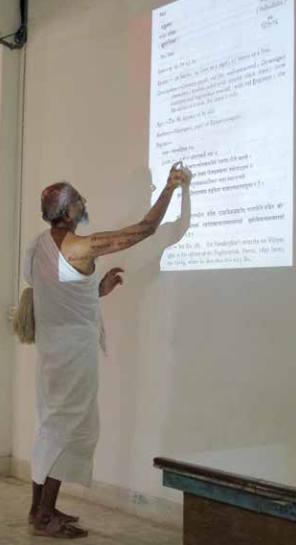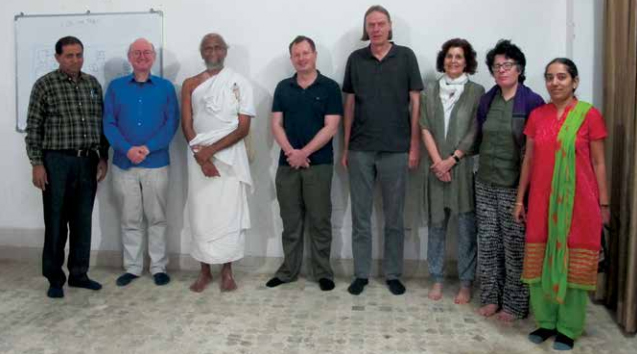
Centre of Jaina Studies Newsletter: SOAS - University of London
In the last two and a half millennia the itinerant Jaina mendicant tradition exerted an important influence on Indian culture and society. From its region of origin in modern Bihar it spread across most parts of South Asia. In the process it segmented into numerous schools, sects, and lineages, which emerged and differentiated in complex interaction with local social and political configurations. Considerable advances towards the reconstruction of the history of the Jaina monastic tradition have been made through the publication and analysis of inscriptions and monastic chronicles. Yet, the social history of Jainism remains imperfectly understood. This is because the principal source, a vast corpus of published bio-bibliographical data embedded in manuscripts and inscriptions, has thus far not been systematically investigated.
Background
The need for more historical information on Jaina mendicants, texts and patrons has long been felt. Until the belated publication in 2016 of Johannes Klatt's JainaOnomasticon (Leverhulme RPG-2012-620),[1] however, only data on selected individuals or lineages were published. Klatt offers comprehensive information, but makes no attempt at cross-referencing and interlinking data. The interrelations and socio-geographical contexts of the documented texts, temples, mendicants and patrons, have never been studied systematically, though suitable materials and analytical strategies abound.
New Methodology
A new research project of the CoJS at SOAS, funded by Leverhulme Trust Research Project Grant RPG2016-454, now explores the relationships between Jaina mendicant lineages and their supporters, focusing on the nexus of monastic recruitment, geographical circulation of monks and nuns, their biographies and literary production, and patronage of mendicant inspired religious ventures. The project is inspired by the overall vision to reconstruct the social-history of the Jaina tradition. It introduces a novel sociological approach to Jaina studies for the analysis of Jaina monastic lineages, networks and patterns of patronage as documented in colophons of manuscripts and inscriptions, using prosopographical methods, advanced digital technology and visualization techniques.
Prosopography is a research tool for studying patterns of relationships, based on the collection and analysis of biographical data about a well-defined group of individuals. It is a useful tool to discern trends and relations that are not clearly visible, and enables the socio-historical study of groups, such as the Jainas, where a vast amount of scattered biographical information instead of extensive life histories of historical individuals is available. Jaina texts present biographical information in formulaic pre-processed formats (birth, family, renunciation, teachers, monastic offices, peregrinations, significant accomplishments and encounters, death, disciples) which are particularly suited to computersupported analysis. The project will integrate and analyse such pre-processed data from five different sources. The computer-assisted prosopographical investigation of the socio-religious history of the Jaina tradition is essential for any future research in this area. It will synthesise and help analysing hitherto unconnected resources.

Aims and Objectives
The specific aim of the project is the sociological investigation of Jaina monastic lineages and relationships between Jaina mendicants and lay-followers by integrating and analysing previously unconnected evidence from different bio-bibliographical sources on more than 30,000 Jaina mendicants, scribes and sponsors from medieval times onward. An innovative data-model and comprehensive prosopographical database developed in collaboration with the Acharya Shri Kailasasagarsuri Gyanmandir in Koba, the Jain Vishva Bharati Institute in Ladnun, and the HRI Digital at Sheffield University will provide rich data for the planned socio-historical analysis of monastic networks and patronage. The open access database will also offer an unparalleled wealth of historical data for future projects on Jaina history and culture.
The employment of the data assembled in manuscript catalogues and compilations of inscriptions for systematic sociological research is just beginning. Sociobibliography in the age of electronic data promises to revolutionise the way in which manuscript catalogues are used. In digitised form the aggregate data embedded in expertly produced catalogues can be used for historical and sociological analysis on a large scale, once the information is transformed into databases that can be used for a multitude of research projects. The approach requires interdisciplinary and international collaboration.
Peter Flügel, principal investigator, and Kornelius Krümpelmann are researchers and co-editors of the resulting data-base, which will be developed by Michael Pidd and Katherine Rogers and hosted by DHI Sheffield, and shared with collaborating institutions. Advisors to the project are Professor J.C. Wright and Dr Renate Söhnen-Thieme (SOAS), Burkhard Quessel (The British Library), Professor Yigal Bronner (Hebrew University of Jerusalem), Professor Karin Preisendanz (Universit of Vienna), and Dr Himal Trikha (Mondes Iranien et Indien, Paris).
An initial project seminar, organised by the CoJS and hosted by the Acharya Shri Kailasasagarsuri Gyanmandir in Koba on 13-15 February 2017, brought together research teams of SOAS (Dr Peter Flügel, Dr Kornelius Krümpelmann), Koba (Acharya Ajaysagarsuri, Dr Hemantbhai Shah, Dr Kalpana Sheth), Jain Vishva Bharati Institute at Ladnun (Dr Vandana Mehta, Dr S.N. Bhardwaj), the Bhandarkar Oriental Research Institute at Pune (Dr Amruta Natu), and The Digital Humanities Institute of the University of Sheffield (Michael Pidd, Katherine Rogers). The seminar focused on the development of a suitable data-model offering enhanced analytical possibilities, while assuring compatibility with already existing data-models of digital manuscript catalogues and prosopographical data-bases. In this way suitable electronic data can be imported from other databases, which in turn will be able to freely use the JainaProsopography data.


 Dr. Peter Flügel
Dr. Peter Flügel